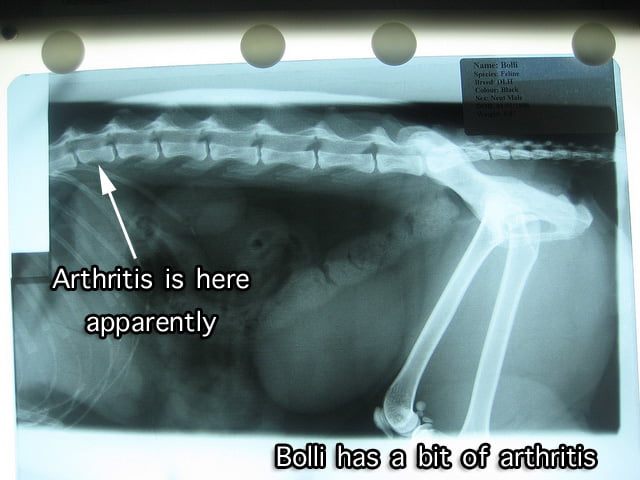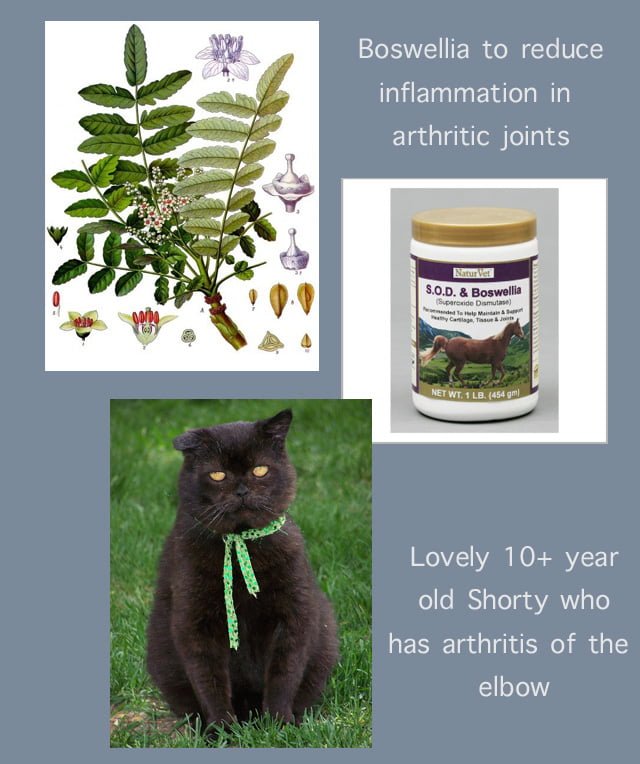I was surprised to learn that in studies concerning the analsis of radiographs of older cats it was found that 90% of cats over 12-years-of-age had evidence of degenerative joint disease a.k.a. osteoarthritis. It is said to be seriously under-diagnosed and extremely common in older cats. Osteoarthritis is a form of arthritis in which the cartilage which cushions the joint wears away, which exposes the underlying bone causing it to become inflamed and painful.

As might be expected, some purebred cats are predisposed to this disease. This is due to selective breeding. For example, hip dysplasia in Maine Coons is not uncommon and neither is knee arthritis in Abyssinians. The Scottish Fold is one of those cat breeds which probably should not be bred despite its popularity with celebrities such as Taylor Swift. Their ears fold because of cartilage problems due to a genetic mutation and therefore perhaps it should not surprise people to learn that they are particularly prone to arthritis in many joints. Elbow arthritis can develop in Burmese cats more than for other breeds.
Common sense tells us that an overweight cat is going to feel the effects of arthritis more than one who is not although being overweight does not cause arthritis. Obesity is very commonplace and elderly obese cats are going to feel unnecessary pain due to arthritis. This is another good reason to keep domestic cat at the right weight.
You can spot joint discomfort in cats despite their ability to hide it. They may reduce physical activity which will obviously disguise their discomfort because they will only feel pain when in motion i.e. when the joint concerned is moved. In addition, an arthritic cat may hesitate when jumping up or down from furniture or windowsills. They may be unwilling to jump and this should be noticeable.

Other signs include: reduced physical activity, going outside less, less hunting or exploring, licking a sore joint, grooming less, hair coat is less well maintained especially those areas where the body has to be contorted for access, sleeping in new areas which are more accessible, finding difficulty in using the cat flap, missing the litter tray if it has high sides, becoming irritable especially if touched or petted on a sore spot and demonstrating a reduced interest and reduce response to petting.
A veterinarian can provide medication and advice on food to help alleviate osteoarthritis discomfort. Some modifications at home can help such as providing a soft comfortable bed in a warm and quiet place. An igloo-type bed maybe popular as might be microwaveable warmers and electrical heating pads if used carefully and monitored. Access to higher places can be facilitated by a carpeted ramp or steps. The same goes for high cat flaps. Flaps are frequently a little way off the ground and a small ramp may help.

If your cat goes outdoors to go to the toilet you might provide an indoor litter tray with low sides. The litter substrate could be of a softer type. As an arthritic cat may have more difficulty in self grooming so you may like to help with some gentle grooming especially those areas which are hard to reach. As arthritic cats are less active their claws are not worn down and therefore they may grow ingrowing claws which enter the paw pads causing an injury. Claws should be checked regularly for elderly cats especially arthritic elderly cats.
A veterinarian would advise a good-quality nutritional joint supplement formulated for domestic cats. They contain essential fatty acids to reduce inflammation, natural glucosamine and chondroitin which helps improve cartilage quality. Free radical damage can be minimised with antioxidants.
As osteoarthritis often occurs in elderly cats there may be parallel chronic conditions such as kidney disease or thyroid problems such as hyperthyroidism. A doctor will advise what sort of medication you can give your cat to help reduce pain. I would be cautious about this. There is one product in this category which I think is dangerous namely metacam.
Sources: Various.

